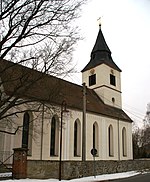Gößnitz
Altenburger LandDuchy of Saxe-AltenburgPages including recorded pronunciationsPages with German IPAThuringia geography stubs ... and 1 more
Towns in Thuringia

Gößnitz (German pronunciation: [ˈɡœsnɪt͡s] ) is a town in the Altenburger Land district, in Thuringia, Germany. It is situated on the river Pleiße, 12 km south of Altenburg, and 20 km northwest of Zwickau. Gößnitz received its town charter in 1718. It is known for the railroad junction of the Leipzig-Hof railway connection and the Central-Germany connection (Dresden - Chemnitz - Gößnitz - Gera - Erfurt) and its station prides itself having Europe's longest platform, as well as the Gößnitz Open-Air. The town's greatest prosperity was at the time of industrialization; Hence Viktor Grimm's representative malt factory from 1889 still characterizes the cityscape.
Excerpt from the Wikipedia article Gößnitz (License: CC BY-SA 3.0, Authors, Images).Gößnitz
Altenburger Straße, Gößnitz
Geographical coordinates (GPS) Address Nearby Places Show on map
Geographical coordinates (GPS)
| Latitude | Longitude |
|---|---|
| N 50.890277777778 ° | E 12.432777777778 ° |
Address
Altenburger Straße 13a
04639 Gößnitz
Thuringia, Germany
Open on Google Maps










